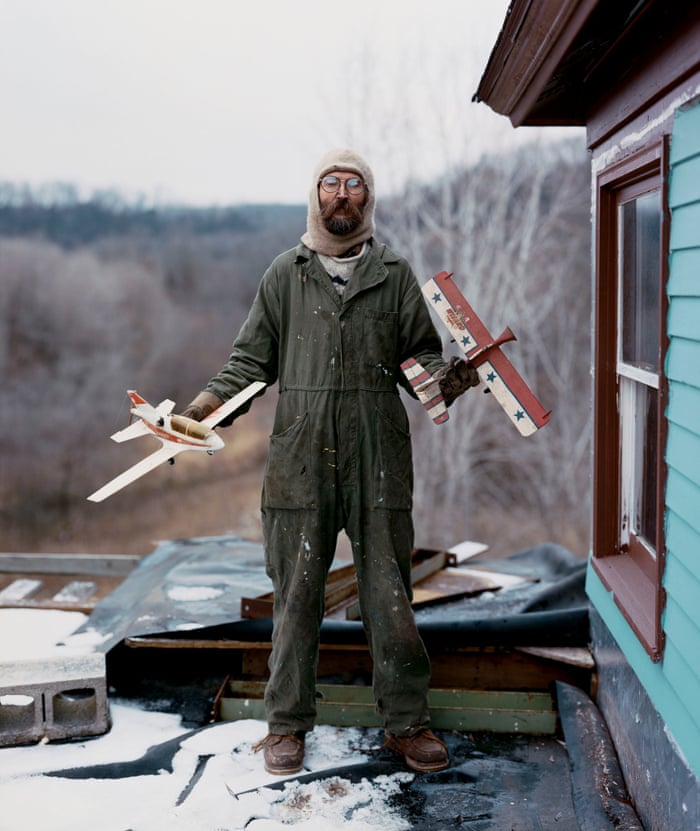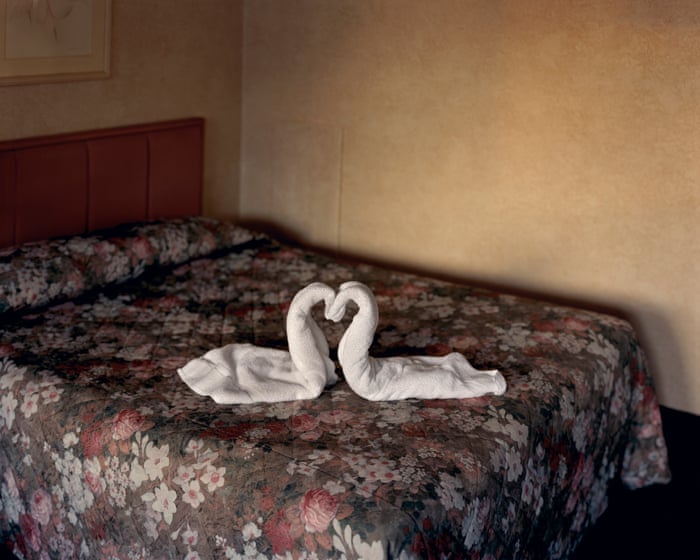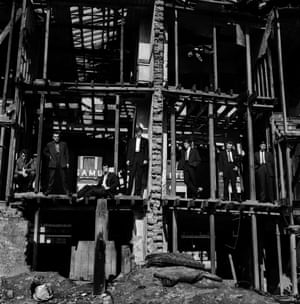I have loads of research to write-up as at the beginning of the year there seemed to be a glut of talks and exhibitions to attend. On January 19th 2017 I was lucky enough to get a ticket to the Magnum Photos Now: New Blood -A discussion on contemporary photographic practices with new Magnum photographers Bieke Depoorter and Max Pinckers.
The discussion focused on the individual practice of Magnum’s new photographers, from traditional photojournalism to a more art based approach to personal projects; and explored ‘what the world-renowned Magnum Photos agency means to contemporary practitioners today.’
Bieke Depoorter
Belgian photographer Bieke Depoorter captures the privacy of people whom she meets by chance and she gets to invite her into their homes. In 2009, she travelled through Russia and later pursued a similar long-term project in the United States. Ou Menya and I am about to call it a day series were published by Lannoo and Patrick Frey and Hannibal. Depoorter joined Magnum Photos as a nominee in 2012, became an associate member in 2014 and a full member in 2016.
Bieke Depoorter received her master’s degree in photography from the Royal Academy of Fine Arts (KASK) in Ghent in 2009.
She works mostly on autonomous projects. Amazingly, I discovered that in 2009, she travelled through Russia, photographing people in whose homes she had spent a single night for her series Ou Menya,
To complete this project, Bieke Depoorter spent three months,divided up into three trips of one month each, following the route of the Trans-Siberian Express’ stopping at the forgotten villages along the way. On reaching a village, she would ask residents if she could stay with them, moving from living room to living room each night. However, she spoke no Russian at all! Instead she had some Russian words scribbled on paper which she would show to strangers who, even more amazingly ‘allowed her to be welcomed and absorbed in the warm chaos of a family.’
The note read:
I’m looking for a place to spend the night. I don’t want to stay at a hotel because I don’t have much money and I’d love to see how people live in Russia. Perhaps I could crash at your place? Thank you very much for your help!
Depoorter states: At first, this note was just a solution to me, but once I started travelling, I realised it was a nice way of entering people’s homes. I decided I would do this every night – and the note eventually became a tool and the centre of my project.
On looking at the rather intimate nature of some of the photographs I found her comments about having difficulties with street photography fairly amusing. Depoorter thought that street photography felt like she was intruding, taking something away from them, stealing in effect, and treating them as objects not people. I guess that the people in her series agreed to the photographs being taken and published in a way the doesn’t happen on the street but I think I’d rather that than my naked butt in a book…
A similar long-term project in the United States led to her second book I am about to call it a day, co-published in 2014 by Edition Patrick Frey and Hannibal.
Bieke Depoorter traveled across the USA asking perfect strangers whether she could spend a single night in their homes. Short but intense encounters are important elements in the work. The openness with which she is welcomed and the intimacy that is shared with her, evoke intriguing moments. These intimate and unexpected situations gave rise to portraits of individuals, couples, and families. Depoorter intersperses them with landscapes. The images are atmospherically charged, some melancholic, some comical, some subtly menacing. They thread a fine line between a real and cinematic world. – Maarten Dings
Depoorter likes to photograph at night, although I don’t think I like the high amount of grain this produces in her images:
I often photograph people at night, just before they go to sleep. I’m interested in the border between the real world and the fantasy world. When people prepare to go to bed, they’re in another mindset. I take photographs during the day as well but at night people aren’t so conscious of me being there.
What I did like about this second set of images was the way she interspersed her portraits with landscape images to tell the whole narrative and link people to place.
Another project she showed us was In Between, where she photographed ‘the intimacy of Egyptian Families.’
Since the beginning of the uprising in 2011 Egypt has been through a period of change. After three years of instability, economic decline, and power shifts, one no longer hears the revolutionary demands of ‘Bread, Freedom, Social Justice!’ in the streets. Most of all it seems the locals long for stability and security.
Away from the politics and news of the day Depoorter searches for the quieter moments that are of course directly influenced by the larger issues. Each day, she searches for places to spend a night, through the people she meets in the side streets in country lanes.
On looking at the images as a whole, you get the overwhelming sensation that as humans we aren’t really that different. The intimate family moments, the pensive looks as people reach the end of the day the home settings aren’t really that far apart. That’s something I think we should all bear in mind in these troubled times.
People are very similar. I wanted to focus on that, rather than the differences. I recently had an exhibition where I mixed all my photographs from the US, Cairo, and Russia: they all fit really well together.
She also shared with us her first short movie ‘Dvalemodus’ shot in 2017, which she directed together with musician Mattias De Craene. The film talks about the everlasting darkness in a small village in the Northern Norway… this was weird and very post-modernist if you ask me…weird angles, music abstract images…possibly a bridge too far for me lol.
What did I take away from Depoorter?
- take risks – although I don’t think I’ll be jumping on a Trans-Siberian train any day soon…
- if one genre of photography isn’t working for you, try something else
- Don’t be afraid of grainy images
- Don’t be afraid to engage with strangers
- Language doesn’t have to be a barrier
- mix portraits and landscapes if it assists the narrative
- shooting at night lends a different light/atmosphere to the images
- you don’t have to be old/established to get into Magnum
- Try to use a more contemporary approach to documentary
Max Pinckers
Not believing in the possibility of sheer objectivity or neutrality, Max Pinckers advocates a manifest subjective approach, which is made visible through the explicit use of theatrical lighting, stage directions or extras. Growing up in Indonesia, India, Australia and Singapore, Pinckers returned to Belgium in 2008, his native country, to study documentary photography at the School of Arts / KASK, where he is currently a doctoral researcher. His last book ‘Lotus’, was published in 2016 by Lyre Press.
Max Pinckers is a photographer based in Brussels, Belgium. He has produced various photo-books such as Lotus (2011), The Fourth Wall, (2012) and Will They Sing Like Raindrops or Leave Me Thirsty (2014). Pinckers has had exhibitions at the MOCAK in Poland (2016), the Philadelphia Museum of Art in the United States (2015) and the Centre for Fine Arts – Bozar in Belgium (2015), among others. Awards include the Edward Steichen Award (2015) and the City of Levallois Photography Award (2013). In 2015 he founded the independent publishing house Lyre Press and became a nominee of Magnum Photos.
Will They Sing Like Raindrops Or Leave Me Thirsty
Magnum photographer Max Pinckers travelled to India for four months, his partner Victoria Gonzalez-Figueras, attempting to grasp, stage and document aspects of love and marriage. This series of photographs focuses on honour-based violence in India; in particular, the violence against women and men who fall in love or have a relationship against their family’s will.
He completed a heck of a lot of background research , combing through newspapers and magazines, watching films and roaming through cities, he looked for subjects that suited his theme, such as couples on their honeymoon at the foot of the Himalayas, men on white horses, photo studios where couples have their portraits taken, strange decors for marriage ceremonies, a stranded photograph of a married couple a set of discarded photos from a studio next to the Taj Mahal and many other things. Max also includes the slightly more abstract images within the body of work, for example a picture of spilt milk references the Bollywood use of milk to symbolise sexual climax – and he cites Burt Lancaster and Deborah Kerr frolicking in the waves in From Here To Eternity as a frame of reference.
His subjects include captured photographs of ‘lovebirds’ (young lovers on the run from their disapproving families due to caste or religious differences) and the Love Commandos – an organization that protects and supports these young runaway couples and helps them get married and start afresh.
Pinckers stages the majority of his images stating: Fiction often teaches us more about reality than reality itself.
In staging his images he uses tripods and often an ‘unneeded reflecting flash, as a footnote, a signature, but also as a spatial photographic intervention.’ This ties in with research completed on documentary performance and fictions, photographers such as Tom Hunter, Mohamed Bourouissa, Essop twins and Jeff Wall, and reveals how Magnum is now accepting the non-traditional ways of representing documentary. His work seems to be following on from the work of Hannah Starkey and Charley Murrell in the form of imagined and choreographed realities.
Pinckers has taken a traditional documentary subject, featuring people who are in very real danger of violence or murder, and handled it with a contemporary twist ‘pulling in a fictional direction using a visual language that borrows from Bollywood and its depiction of relationships and love.’ There are an estimated 1,000 honour killings in India every year, but it’s also a problem that extends across much of Asia, Africa, into Europe and the UK.
The purely staged shots are mixed with photographs of moments restaged from real life. We see an image of a man and woman standing on corrugated iron rooftops on a Mumbai beach. She is throwing a paper plane to the man, a message of her forbidden love. The lighting is garish, the location opportunistic and anonymous. It seems as though we are in the 1970s again. But the picture is a recreation of the courtship of Sanjay and Aarti, the most celebrated of the couples rescued by the Love Commandos. After Aarti’s parents found out about her relationship with Sanjay, they beat her and tried to sell her three times. Once she was sold to a couple for £140 as ‘a slave for extramarital relations’. Aarti complained so much that she was returned to her parents from whom, with help from the Love Commandos, she eventually escaped. Reaching out into a fictional world, Pinckers shows us Sanjay and Aarti in their new home. Aarti is holding a baby, Sanjay is switching the television on and the walls are covered in peeling blue paint and irregular brickwork. The struggle for love is over; now the struggle of life begins.
The Fourth Wall
Weaving reality and fiction, Max Pinckers examines the Indian film industry and its ingrained influence on Indian culture.
Nowhere else is there such devotion to cinema as in India.This fictional world seeps into reality and influences everyday life, dictating the perception and imagination of its audience
Rather than focusing on the more obvious, such as advertising billboards or Bollywood bling, Pinckers turned the streets of Bombay into his own set, inviting passers-by to participate. He says: ‘The people in these images become actors by choosing their own roles, which they perform for the camera and its western operator…Conscious of the power of images, they give it their all, reflecting on their silver screen dreams by embracing their collective visual world and creating their own brief moments of suspension of disbelief.’
A bit like Murrell who mixes reality and fiction, Pinckers does the same, confusing fact, fiction, and documentary capturing scenes in which it is a combination of both staged and spontaneous moments. Max explains:
A photograph of two men in uniform climbing over a fence, escaping …a re- enactment of a moment that just passed. They do it over again with great pride and pleasure.
[For another tableau] I read an article in the newspaper: two men use sleep-inducing gas to rob a struggling actress in her home, the same gas used in a 1972 hit film in which a cook robs his landlord. An image that I’ve been planning to make for some time comes to mind – a thick cloud of smoke in a bedroom film set.
Traditionally, Western photographers have approached Mumbai, where most of these images were taken, ‘from a humanitarian perspective, using people – their expressions, gestures, moments of clarity – that might symbolise the social realities of the city.’ In this body of work Pinckers has a different approach. The fourth wall, in dramatic terms, forms the imaginary screen through which the audience sees the scene unfold. The actors, conscious of this barrier, tend to break through it now and then by hinting at their own fiction, acknowledging the camera and the act. In this body of work Pinckers has ‘applied this concept to documentary photography by way of commenting on the paradoxes of his chosen medium.’
I have consistently been exploring the boundaries of documentary photography and its narrative power. Naturally this suggests a blurred boundary between genre’s and definitions, although I would place my work primarily within a documentary context.
Lotus
Max Pinckers, in collaboration with Quinten De Bruyn, documented the lives of transsexuals in Thailand, whilst exploring the boundaries and the role of contemporary documentary photography. In Lotus, the gender crisis that the
so-called ladyboys face is transformed into a visual metaphor about the identity crisis that contemporary documentary photography currently encounters, when it dares to reflect upon itself critically, and confront its paradoxes.
The documentary photographer that captures reality as ‘a fly on the wall’ can’t deny his or her directive and manipulative role any longer. The anonymity, the seeming absence, is merely a pose. The tableaux that the photographer captures are not lies, but enfold themselves within the studio that he or she creates from reality.
Other pertinent facts are he self publishes and The Fourth Wall was completed due to a crowd funding exercise. His current project is based around the Mau Mau Uprising of the 1950’s where he is tracking down people who were involved at the time and re-enacting some of the scenes. Max also wants to include some of the ephemera that he is discovering left behind in archives. At the time of the talk this was a work in progress.
Neither Depoorter nor Pinckers want to caption their work.
What did I take away from his work?
- That even more so I can see the benefits of staged documentary images
- Lots of research assists in getting the right shot
- it is important to choose a subject with a powerful narrative
- collaborating can be good
- you can mix portrait and abstract shots within the same body of work
- be experimental/contemporary with your approach
- Crowd funding can work if you want to control your publication or if you are rejected by large publishing houses
Again a very informative talk which has opened my mind to many opportunities for capturing documentary work.
Research
https://www.magnumphotos.com/events/event/magnum-photos-now-new-blood/
https://www.magnumphotos.com/photographer/bieke-depoorter/
https://www.vice.com/en_uk/article/bieke-depoorter-photography-magnum-interview-876
http://www.ideastap.com/IdeasMag/the-knowledge/bieke-depoorter-Magnum-photographer
http://www.biekedepoorter.com/
https://www.magnumphotos.com/photographer/max-pinckers/
http://www.bjp-online.com/2015/07/learning-about-love-from-bollywood/
http://tacohiddebakker.com/texts/the-fourth-wall-an-interview-with-max-pinckers/













































































































































































































































































